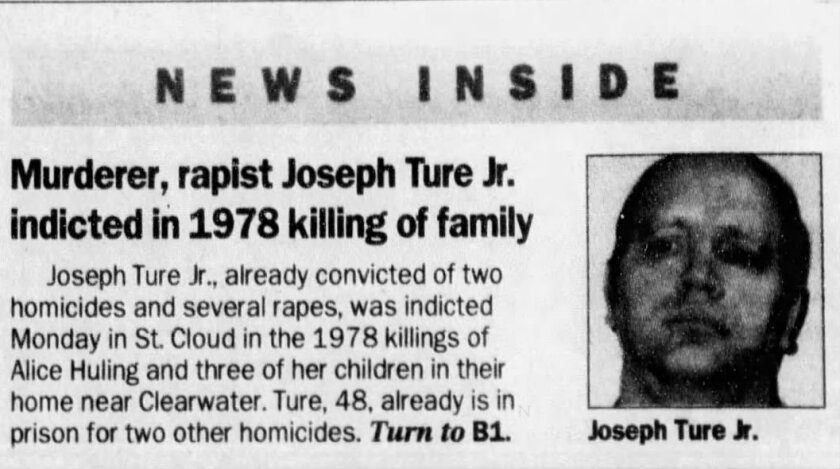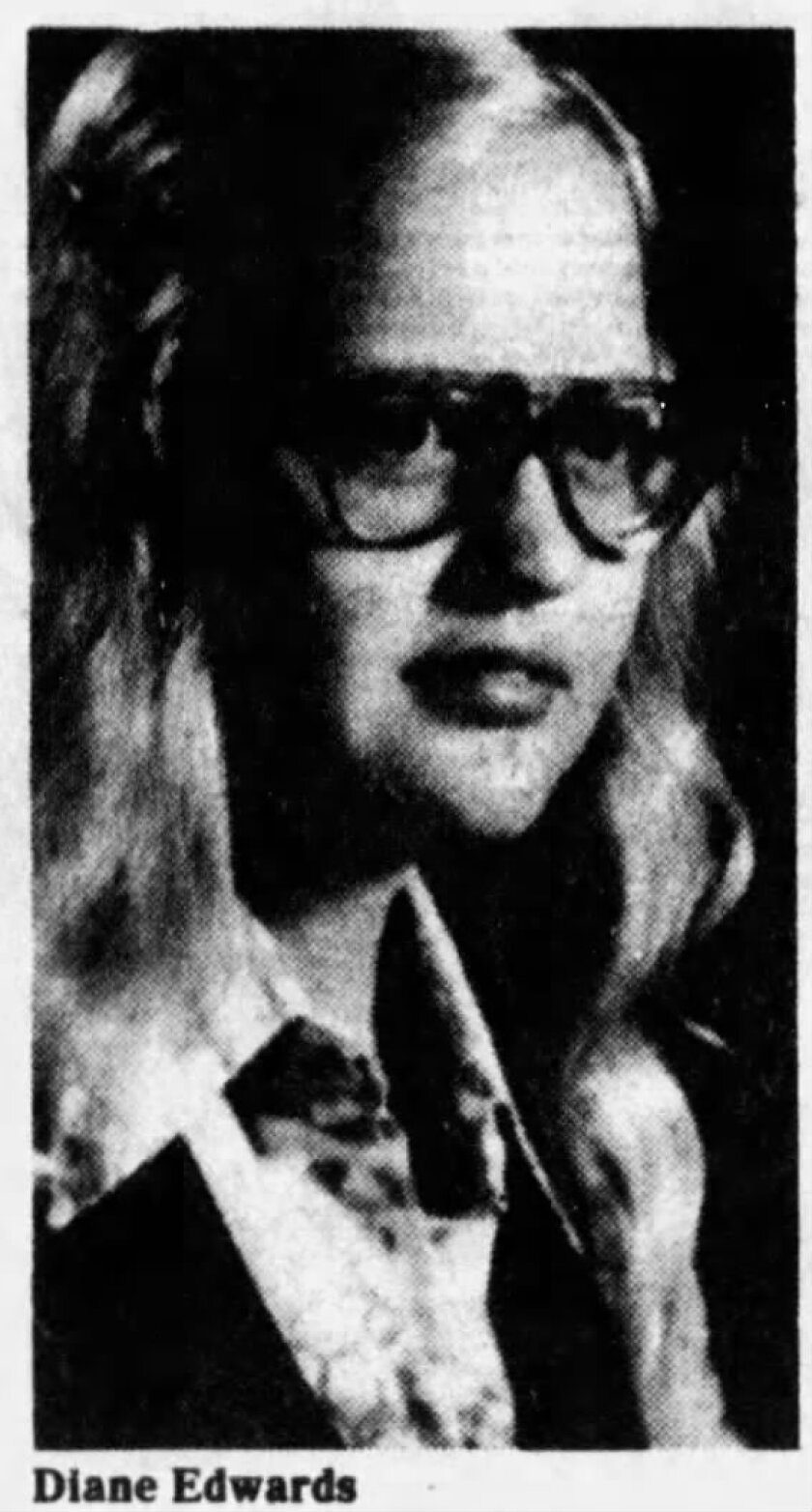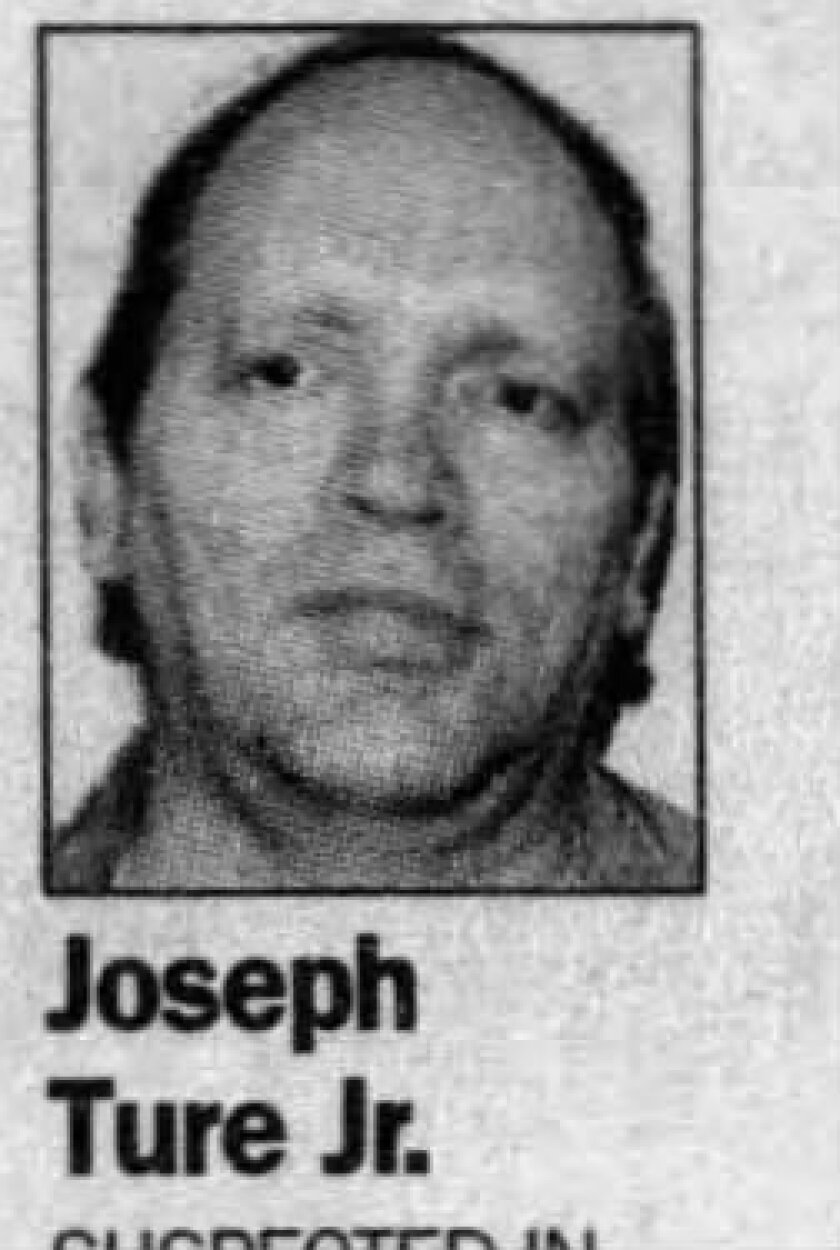STEARNS COUNTY, Minn. — Joseph Ture’s two-year reign of terror resulted in six murder and multiple sexual assault convictions — and left investigators wondering if there were more victims.
Ture is serving six life sentences in a Minnesota prison for the murders of a 36-year-old mother and her three children, in addition to the slayings of two young women.
ADVERTISEMENT
In 1978, he entered a Clearwater home and shot Alice Huling before going upstairs and killing three of her children, ranging in age from 13 to 16 years old. Her 11-year-old son escaped — and testified in Ture’s trial.
His conviction for the Huling murders came in 2000 after a Bureau of Criminal Apprehension cold case review unveiled evidence pointed at Ture.
At that time, he was already serving two life sentences for the murders of Marlys Ann Wohlenhaus and Dianne Edwards.
In 1979, Ture killed 18-year-old Wohlenhaus after breaking into her Afton home, where he waited for her to return from school.
Her mother came home to discover she had been bludgeoned to death with a hammer, according to court documents related to Ture’s unsuccessful appeal.
Ture wasn’t convicted of Wohlenhaus’ murder until 1998, years after he confessed in writing and in person with Sherburne County officials while awaiting his trial for the murder of 19-year-old Dianne Edwards.
Officials brushed off the confessions after checking his work schedule, which they determined would not have made it possible for him to commit the murders. They believed he was working.
ADVERTISEMENT
A Bureau of Criminal Apprehension cold case review revealed investigators initially checked the work schedule of his father, who goes by the same name.
Ture was not working the day Wohlenhaus was killed.
A year after Wohlenhaus was killed, Edwards was stabbed to death on her way home from work. Her body was discovered in a West St. Paul park in 1980.
Ture arguably wouldn’t have been convicted in Edwards’ death had he not been caught raping and kidnapping young women in 1980, which landed him behind bars for the first time.
As investigators combed through the details of Ture’s rape convictions, they began to consider him for unsolved murder cases, including Edwards’.
There is still reason for investigators to believe there were more victims, including Joan Marie Bierschbach, whose remains were found near Monticello in 1984, five years after her disappearance.
Connecting the evidence
The known beginning of Ture’s violent acts against women began after his 1980 arrest for snatching women off the streets of Minneapolis and St. Paul.
ADVERTISEMENT
Two women told investigators he abducted them at knifepoint before sexually assaulting them in his vehicle. Another woman told law enforcement she escaped from Ture’s grip, fleeing from his car after fighting him off.
With demonstrated acts of violence, investigators began to ask themselves: Are there more victims out there?

That thought process led them to consider him as a suspect in the slaying of Diane Edwards, whose body was discovered in a field six miles outside of Elk River in October 1980.
Edwards was considered a missing person after she was abducted in St. Paul while walking home from her job as a server at a Perkins restaurant.
Four witnesses told investigators they saw a man with shoulder-length, light hair force Edwards into his rusted, dark-colored station wagon, according to a 1980 Star Tribune article.
Edwards’ body was found after a hunter came across a purse in a remote area outside of Elk River. Investigators searched the area, where they discovered Edwards’ naked body next to her clothing, which had been neatly folded.
The known suspect in this case matched Ture’s description at the time — the type of vehicle did, too.
ADVERTISEMENT
The way in which Edwards was abducted fit Ture’s known tactics: She was forced into a vehicle and taken away. Yet this time, Ture didn’t allow his victim to escape.
While in custody for his string of kidnappings and sexual assaults, Ture was charged with the murder of Edwards — and he confessed.
Ture attempted to convince a jury in December that his confession was motivated by his interest in a reduced sentence. They didn’t buy it.
By December of 1981, he was convicted and sentenced to life in prison.
Conflicting confessions
Ture was considered a suspect in the slaying of 18-year-old Wohlenhaus from the start, although a false alibi cut him loose from the investigation.
While awaiting trial for the Edwards case in 1981, Ture signed a detailed written confession stating he also killed Wohlenhaus, who was found bludgeoned to death in 1979 in her Afton home.
The confession prompted investigators to look into Ture as the perpetrator, but ruled him out when they confirmed he was working at the time of Wohlenhaus’ death.
ADVERTISEMENT
With a so-called alibi, law enforcement crossed Ture’s name off their list — until 1990, when a BCA cold case investigator discovered Ture also confessed in person to Sherburne County officials that he killed Wohlenhaus.
David Hofstad worked for the Sherburne County Attorney’s Office when he was told by a local reporter in November 1981 that he should speak with Ture about the Wohlenhaus slaying.
So, he did.
Ture told Hofstad a different version of his confession. In the written confession, penned by a fellow inmate and signed by Ture, he confessed to entering Wohlenhaus’ home to kill her mother. He claimed he worked for Wohlenhaus’ father, who asked that he kill his wife, according to court documents related to Ture’s appeal.
Ture claimed Wohlenhaus came home and rejected his sexual advances, prompting him to kill her.
His verbal confession included an entirely different story.
Ture told Hofstad he was interested in dating Wohlenhaus and was familiar with her through her job as a server at a local restaurant. He told Hofstad he entered through the garage and waited until Wohlenhaus walked in through the front door before killing her with a crowbar or hatchet, according to court documents.
ADVERTISEMENT
Despite the written and verbal confessions, Ture was not charged until 1996 — after investigators realized Ture’s alibi was misguided. Officials with the Washington County Sheriff’s Office had mistakenly looked up the work schedule of Joseph Ture’s father, who goes by the same name.
Nearly two decades after receiving a life sentence for the murder of Edwards, Ture found himself in a courtroom, where he was convicted in 1998 for the murder of Wohlenhaus.
The judge handed down another life sentence.
Ture unsuccessfully appealed the conviction, claiming he only confessed with the hope of his life sentence being reduced.
His appeal was denied.
Justice delayed
Former Stearns County Sheriff Jim Kostreba was a deputy on Dec. 15, 1978, when he entered the Clearwater home of Alice Huling.
With the smell of gunpowder still in the air, Kostreba saw 36-year-old Huling clinging to life with a gunshot wound to the right side of her head.
“She was attempting to take little gasps of air every 15 to 20 seconds,” Kastreba told the St. Cloud Times in a 1998 interview.

When Kastreba made his way upstairs, he discovered three more casualties. Alice Huling’s children — Susan, Patti and Wayne — had been shot and killed in their beds.
William Huling, who was 11 years old and the youngest of the four children, managed to escape by hiding in his bedroom and fleeing to a neighbor’s house.
Ture was arrested for the Huling murders in 1999.
Officials had arrested Ture for an unrelated crime nearby just days after the Huling murders, though.
Four days after the four family members were found dead, Ture was arrested at a nearby travel station for driving a stolen vehicle. When searching the vehicle, law enforcement discovered a list of nearly 200 women, along with detailed information and their descriptions.
“He’d have a description of what she wore, looks like; he had over 100, close to 200 waitresses, where they worked, what they wore, what they drove,” BCA Special Agent Everett Doolittle told “48 Hours.”
Officers also found a ski mask, a metal bar and a toy car, all items that were kept as evidence by the Stearns County Sheriff’s Office.

While serving time at the Sherburne County Jail in 1981, Ture asked his cellmate to pen a written confession on his behalf for the murders of the four Huling family members. The confession, signed by Ture, was handed over to law enforcement officials — but Ture wasn’t pursued beyond that.
“Although the police obtained a copy of the written confession and questioned Ture on several occasions about the confession and the murders, no charges were brought against Ture,” court documents related to Ture’s appeal state.
Nearly two decades later, Ture confessed to another inmate. This time, the confession came with charges.
In May 1999, Ture was charged with four counts of first-degree murder.
At trial, William Huling testified.
At around 4 a.m. on Dec. 15, 1978, he heard a loud noise coming from the downstairs of his home, followed by footsteps making their way up the stairs. He hid as he witnessed his older brother ask the man what he was doing there, before being shot.
He then heard the man walk toward his sisters’ room — followed by the sound of gunshots.
The toy car discovered in Ture’s stolen vehicle four days after the Huling murders played a critical role in the trial.
William Huling said it looked like the toy he played with as a child.
The written confession Ture had his fellow inmate write in 1981 also came into play.
In the letter, Ture said he was angry with Alice Huling because she wouldn’t allow him to date her daughter, Patti, who he referred to in the letter as “Pat.”
Ture said in the signed confession that he went to the Huling home to “rape” Patti and beat the rest of the family with his “billy club,” according to court documents.
“The letter states that Ture shot Alice with his shotgun above the knees and hit her a couple of times because she woke up and recognized him, even though he had a ski mask on,” court documents state. “The letter states that Ture then went upstairs and shot two girls and one boy. The letter indicates that Ture returned to Alice, told her what he had done, beat her with his fists and his ‘billy club,’ and then shot her in the head.”
Ture was convicted on four counts of first-degree murder in January 2000, resulting in four additional life sentences.
An unsolved case
Joan Marie Bierschbach was 20 years old when she was reported missing on Nov. 5, 1979, after she left her apartment to play volleyball in Waite Park. Her vehicle was later discovered at a Perkins in St. Cloud.

Her missing persons case remained unsolved for five years until investigators tested the remains of a young woman discovered in Monticello in 1984.
They belonged to Bierschbach.
In June of 1998, Ture became the main suspect in her case.
A woman claimed she saw a man and a woman fitting Bierschbach’s description having a conversation at Perkins the night she went missing. In a lineup, the witness picked Ture as the man she saw that night.
A fellow inmate also said Ture confessed to killing Bierschbach, claiming he waited for her to leave Perkins before forcing her into his vehicle, where he stabbed her before taking her to Monitcello, according to a 1998 article in the St. Cloud Times.
The prosecution argued in a 1998 hearing that Ture likely went inside Perkins to ask her for a ride after stalking her for quite some time. When she declined, he waited for her outside before abducting and killing her, they claimed.
The defense countered the theory, claiming the story given by the fellow inmate had changed from its initial version.
Bierschbach’s case remains unsolved.









